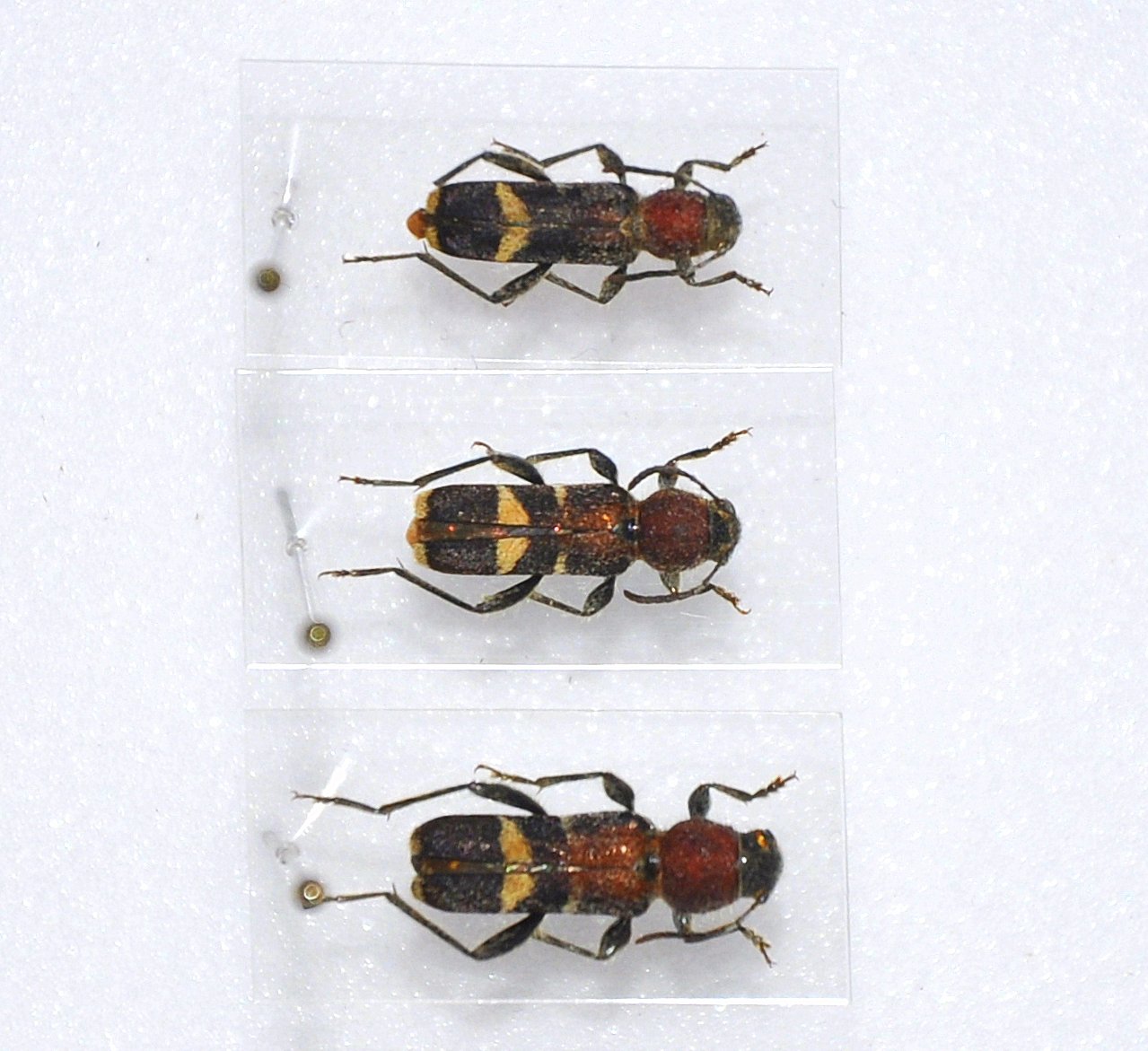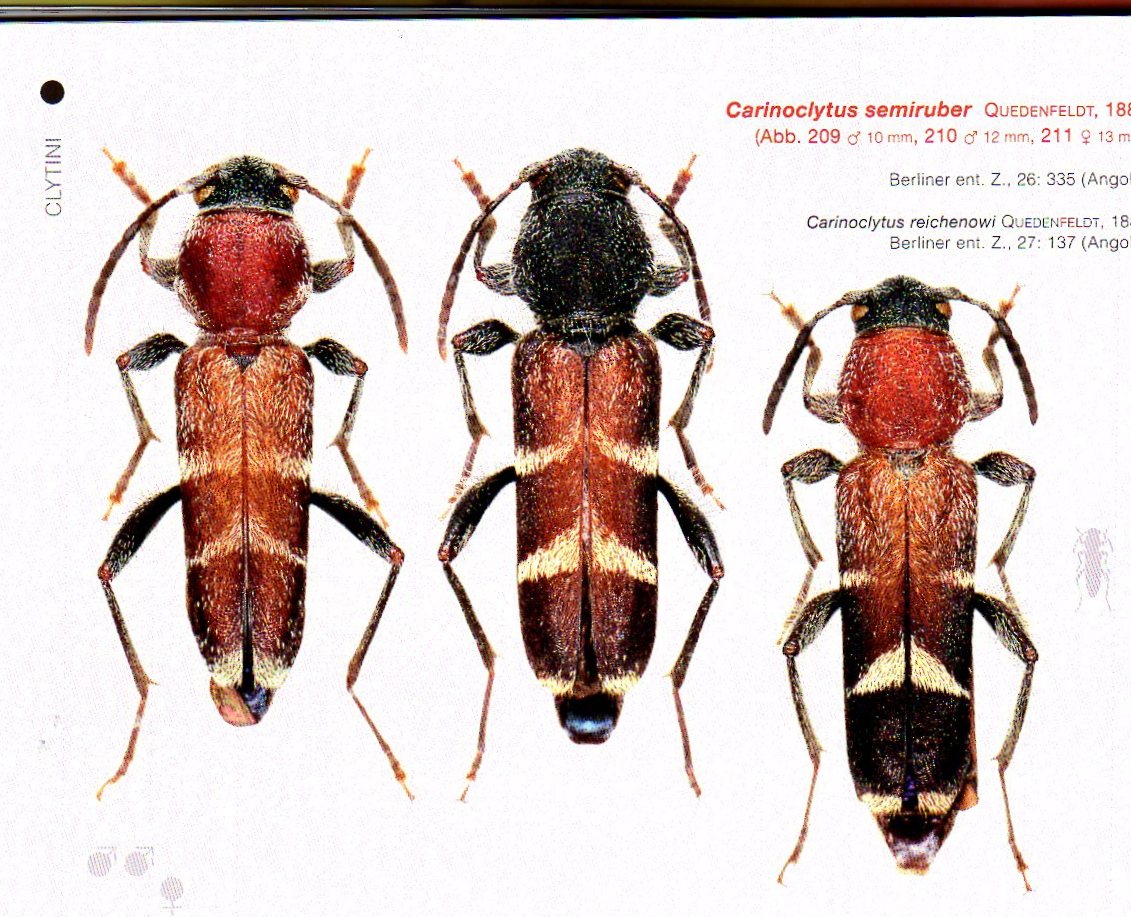| T O P I C R E V I E W |
| Pierre |
Posted - 01/03/2010 : 21:29:26

Clytini from Tanzania.
Their colouration remember our European Clerus!
9 to 11 mm
|
| 12 L A T E S T R E P L I E S (Newest First) |
| Francesco |
Posted - 15/05/2015 : 07:20:46
quote:
Originally posted by Pierre
Merci Carlo pour l'illustration: continue comme ça, cela nous évitera d'acheter le livre d'Adlbauer!!
Adlbauer sera hyperheureux de cela     
|
| Pierre |
Posted - 15/05/2015 : 07:17:01
Bien, il faut dire que la description de Quedenfeldt est quand même très précise. Elle mentionne à la fois des caractères différentiels mais indique aussi la variabilité de semiruber tant au niveau des integuments que des bandes.
La question de la forme de la bande triangulaire (étirée en forme de triangle à la suture vers l'avant = semiruber) ou rhombodoïnale (étirement triangulaire vers l'avant et l'arrière = thomsoni) concerne logiquement la postmédiane.
Je viens de contrôler la longueur de la carène frontale, bien présente et parcourant finement le vertex.
Merci Francesco de ne pas oublier les très vieux posts comme celui-ci. Parfois je me demande comment tu fais pour te souvenir de tout ça.
Merci Carlo pour l'illustration: continue comme ça, cela nous évitera d'acheter le livre d'Adlbauer!! |
| Francesco |
Posted - 15/05/2015 : 06:44:29
Bof... on lit l’allemand tout le deux Pierre.
Selon Aurivillius (p. 336), thomsoni a l’écusson couvert de pubescence blanche, les élytres de pubescence noire et les bandes jaunes (donc la "postérieure" est rhomboïdale  ... mais ici je ne comprend pas si on parle de l'apicale ou de la postmédiane). ... mais ici je ne comprend pas si on parle de l'apicale ou de la postmédiane).
Ensuite on parle de la carène (?) frontale, mais là, je n’arrive pas à voir. |
| Pierre |
Posted - 14/05/2015 : 22:46:24
Euh... j'ai donc bien compris, avec tous ces changements on en est donc à semiruber? |
| Carlo |
Posted - 14/05/2015 : 22:05:22
Giusto per vivacizzare un po' 

255.75 KB |
| Francesco |
Posted - 14/05/2015 : 21:49:33
En revenant à ce topic, je pense que ton espèce soit en effet Carinoclytus thomsoni (Harold, 1880), qui diffère de semiruber (= reichenowi) pour son dessin jaune. La description est dans la même page de celle de C. semiruber (mentionnée ici-dessus).
L'espèce, connue du Kenya, pourrait etre nouvelle pour la Tanzanie. |
| Francesco |
Posted - 02/02/2011 : 14:52:33

Xylotrechus Reichenowi Quedenfeldt, 1883, Tab. 1, Fig. 4
Finally, I have found the original description (here p. 335) of Carinoclytus semiruber (Quedenfeldt, 1882) and the original drawing of Xylotrechus reichenowi Quedenfeldt, 1883 (here p. 137), which Adlbauer recognised as a synonym of semiruber.
This latter species has the pronotum black instead of red, but the elytral pattern seems to correspond to your specimens... |
| Francesco |
Posted - 06/03/2010 : 12:15:28
Yes: unfortunately, the few papers often also have no pictures, though the number of genera and species is very small.
That is why the majority of Clytini has diurnal phenology, a behaviour little advisable in Tropical regions due to climatic reasons. Correspondingly, in these regions some genera (e.g. Xylotrechus, Neoclytus) has a nocturnal phenology, a fact explaining their dark aspect, sometimes completely missing of light pattern. |
| Pierre |
Posted - 05/03/2010 : 21:21:22
I have the feeling that African Clytini are very little known and only a few literature exists.
It's good to have at least an indication concerning the genus.
Thank you! |
| Francesco |
Posted - 05/03/2010 : 09:10:20
By basing of your description, I guess it might be a Carinoclytus-species.
Unfortunately, I do not have full descriptions of this genus. |
| Pierre |
Posted - 03/03/2010 : 18:55:35
The entire head is densely punctate and covered with white erect setae (such as the whole body of this beetle). One fine smooth carina runs from the neck until the labrum and separates the head entirely. Each side shows 2 other carinae next to the eyes: one, longer on the facies and a second, shorter, up to the antennal insertions. |
| Francesco |
Posted - 03/03/2010 : 10:21:01
This species has the same pattern and distribution of Chlorophorus deterrens (Pascoe, 1862), but it does not seem to belong to the same genus.
Could you check if the forehead is carinate or smooth? |


